Free Electricity from the wind with turbines
New wind turbines with a maximum output of 800 watts complete with tower and
guy ropes
Application
The turbine has an AC 3 phase output from a PM alternator, this is the most
efficient design for maximum output. The output from the turbine will need to be
rectified to DC using a standard 3 phase bridge rectifier.
After this, the output, (36v dc) can be used to charge a battery bank (say
3 12v batteries in series)
If you wish to install a charge controller this will connect across one of
the batteries and monitor its voltage, when it gets to 13.8 it will switch the
output from the turbine to a dummy load, when the battery drops to 12v it
switches back to charge mode.
A dummy load can be a heating element, water heater, lighting etc. Without a
load the turbine could run too quickly.
If you are using a battery bank you could run 3 separate 12v 'rails' to
supply an 12v equipment.
The turbine body measures 50x22cm and weighs approx 25kgs, it has slip rings
for the output and will turn out of the wind in extreme conditions.
The mast and tail shaft are galvanized steel, the body is fibreglass.
Installation of the tower
The tower has a large base plate with four bolt holes, these needs to be
bolted down into a concrete base. The steel cables anchor the tower in place
using steel pins that again need to be concreted into place, the cables are
tensioned using adjusters (supplied)
you can either assemble the tower with the turbine in place and winch it up
or assemble the tower and then add the turbine using a scaffold tower.
Turbines do make a noise, they are not completely silent!
Finally shipping, if you wish to collect that's fine, just call us otherwise
shipping is AT COST.
| Output |
36v AC |
| Blade diameter |
2.7 metres |
| Tower height |
5.7 metres |
| Cable length |
13 metres |
| Rated wind speed |
8 m/s |
| Number of blades |
3 |
| Rated rotate speed |
400 r/min |
| Maximum generating capacity |
800 watts |
| Tail length |
1.7m |
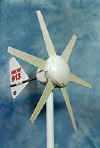 |
RUTLAND 913 WIND GENERATOR
The Rutland 913 is designed for marine use on board coastal and ocean going yachts usually over 10m in length. This unit will generate enough power to serve both domestic and engine batteries on board and the RWS200 Controller is available for dual battery charging.
Why is The Rutland so unique
The Rutland 913 is a popular sight in marinas, thousands are in use worldwide, boat owners like it's clean, aerodynamic lines and its quiet and continuous operation. Without doubt this latest marine model accumulates more energy than any other comparable windcharger available, you'll always see a Rutland spinning in the lightest of breezes! |
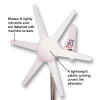 |
Technical Data
Low wind speed start up of just 5 knots
Generates 90w @ 19 knots, 24w @ 10 knots
Delivers up to 250w
One way only fit fine profile efficient aerofoil blades
Three phase Rutland "unique" generator design
Automatic thermostat protection in prolonged gales
Modern, durable materials for reliability on the high seas
No radiated interference - complies with EEC directive 89/336/EEC
Shipping Specification (mm)
1 Carton 360 x 360 x 600
Nett weight:10.5kg
Gross weight: 13kg
|

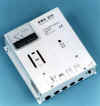
|
SR200 Regulator - Shunt type regulator prevents battery overcharge
RWS200 Controller - Incorporates the SR200 Regulator, charge ammeter, dual battery voltage LED's, two battery connection terminals and switch for charging one or two battery banks simultaneously, solar panel input (maximum 50w when used in combination with FM910-3
windcharger). Housed in attractive white case with simple to follow graphics for installation.
|
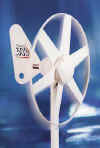 |
RUTLAND 503 WIND GENERATOR
A completely unique mini windcharger designed with the weekend yachtsman in mind. The Rutland 503 is ideal for trickle charging batteries on board vessels less that 10m in length with battery banks of up to 100Ah. This latest model follows the success of its predecessor the Rutland 500 with a number of enhancements including performance and styling.
Why is The Rutland so unique
"Safety turbine" is a single injection moulding of 6 aerofoil blades protected by an outer ring.
Trickle charges in windspeeds as low as 5 Knots Produces 25w in 19 Knots Produces up to 60w, nominally 5A @ 12V in 50 Knots
Stainless steel fasteners and marine grade materials Turbine diameter of 500mm
Compact turning radius of just 225mm, great for when space is at a premium
Latest design improvements - the Rutland 503 is more reliable and efficient than ever!
No radiated interference - complies fully with BS EN5008-1 1992
Shipping Specification (mm)
1 Carton 550 x 550 x 260
Nett weight: 3.5kg
Gross weight: 6kg
|
|
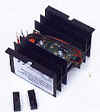
|
SR60 Shunt Regulator for Rutland 503 Wind Charger
Offers simple over-voltage regulation for single battery banks. For use with the Rutland 503 wind charger. Rated power of 60 watts and diode protection. Dimensions: 75mm x 100mm x 53mm |
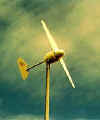
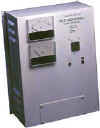
|
Rutland Furlmatic 1803 WIND GENERATOR
The FM1803 is another product technological advancement engineered by Marlec. It follows the great success achieved with the original Rutland Furlmatic FM1800 which has established a proven track record of reliability in a variety of applications from the cold, harsh environment of Antarctica to the hot, dusty climate of the Sahara Desert.
The Furlmatic 1803 is Marlec's largest power unit incorporating a "furling" tail system designed to orient the turbine at 90degrees to the prevailing wind in wind speeds above 35mph (15m/s). This allows the turbine to slow down, continuing to produce power whilst reducing wear on the unit. Use on land based applications where windspeeds are frequently high and sustained over long periods.
Below you will see the performance specification and the dimensions of the Rutland 913.
Why is The Rutland so unique
It's new aerodynamic proportions are designed to deliver maximum efficiency from its 1.8m diameter 2-bladed turbine. We've given the FM1803 a new aerodynamic styling and the latest generator technology to deliver nearly 40% more power without increasing the turbine size. In fact we've reduced the weight but the FM1803 is still as robust and "heavy duty" as its predecessor.
Suitable applications include off-grid homes, telemetry stations, telecom sites, radio/tv transmitter stations, rural clinics for refrigeration and lighting, meteorological stations, security systems, navigation aids, portable power for expeditions and military field applications, etc.
Whatever the application you'll find using the FM1803 is convenient, reliable and cost effective. It can be used alone or in conjunction with solar panels and/or a diesel generating set to create your own stand-alone power system free of costly grid installation and on-going costs.
Includes automatic operation controller incorporating battery overcharge protection, manual stall switch to idle operation for battery maintenance, charge ammeter and battery voltage indicator
AC voltage transmitted to controller to allow optimum windcharger siting whilst minimising voltage losses
Latest 3-phase alternator design
Composite aerofoil blades of durable glass fibre
Automatic furling system activates in excessive winds to mechanically protect turbine and reduce stresses
Controller available in 12v or 24v, windcharger unit is identical for both
Designed to mount on 81mm internal diameter tube
Other System Components:
Batteries - A battery bank of deep cycle lead acid cells of the non-sealed type only are recommended with a minimum capacity of 300AH @ 12V or 200AH @ 24V
Cable - Three core cable is required between the wind generator and controller, the thickness of this cable depends on the length and more details are given in the Installation Manual. Distances up to 50m should use 1.5mm≤ cable.
Mounting Pole / Tower - a minimum height of 6m of 81mm inside diameter tube supported by a minimum of 4 guy wires is necessary. Further details are given in the Installation Manual.
Shipping Specification (mm)
1 Carton 470 x 400 x 1175
Tower top weight: 38.5kg
Gross weight: 55.14kg
|
| |
|
Supplied with complete control electronics
Wind turbine performance specifications are not created equal......
That's because to date there are no firm international standards for how small wind turbines are "rated." Most grid connect wind turbines are given a power specification at 10m/s (meters per second), the equivalent of 22mph or 19Knots. They do of course produce more power in stronger wind speeds.
Bull chooses to rate our wind turbines at this same standard of 10m/s as we believe that as the industry matures a reasonable level such as this one will be established. Manufacturers rating points vary and consequently it is necessary to compare output graphs across a wide band of windspeeds rather than accept individual rating figures for wind turbines.
So how much power will a windcharger deliver?
The real measure of performance of wind turbines is "accumulated ampere hours" into a battery over a given period of time although this is a difficult measure for manufacturers to express since the users site for the windcharger will affect overall performance. Output graphs are usually an indication of instantaneous peak power at given wind speeds but in real conditions the wind is rarely constant, usually gusting up to 3 or 4 times the average.
Wind turbines can theoretically deliver 4 times the power in twice a given wind speed so calculating total power generated using average wind speeds is misleading.
As an example we will take 10 Knots as the average wind speed using a Rutland 913 Windcharger:
the Rutland 913 delivers 1.5A @ 10knots, then we could estimate a daily yield of 24hrs x 1.5A = 36Ampere hours. However at the extreme the wind may blow at 20 Knots for 12 hours and be calm for 12hours, showing 10Knots as the average so the potential power generated can be quite different, ie at 20 knots the Rutland 913 delivers 7A, therefore 12hrs x 7A = 84 Ampere hours.
The actual accumulated ampere hours in reality is somewhere in the middle demonstrating that average figures can be misleading. This also reinforces the benefit of wind generators that run freely in low winds maximising the available power of the more regular gentle breezes as well as the peaky gusts.
Consider the "fill factor"
The wind never blows constantly from one direction or at a steady wind speed, it blows in gusts. Most micro wind turbines are fitted with a free yawing mechanism and tail fin to direct the turbine into the wind. Where they differ is in the type of generator and aerofoil blades used which greatly affect their ability to adapt to the changing wind conditions. An unrivalled feature of all the Rutland designs is low wind speed performance. Our high inertia generators maintain momentum and speed between gusts of wind, continuing to generate power where more conventional designs slow down losing power and requiring a strong gust of wind to restart them. This means that overall a Rutland will generate more power into a battery bank in a day when compared to an equally sized or rated turbine and even in cases of generators of a higher "rated" capacity and turbine diameter! See the independent tests on our news pages and compare the turbine diameters to see that you don't always need a larger unit to generate the same or more power.
To sum it up:
We keep it simple so it's reliable
We use durable materials so it lasts
We innovate to deliver the best efficiency possible
Low wind speed start up of just 5 knots
Generates 90w @ 19 knots, 24w @ 10 knots
Delivers up to 250w
One way only fit fine profile efficient aerofoil blades
Three phase Rutland "unique" generator design
Automatic thermostat protection in prolonged gales
Modern, durable materials for reliability on the high seas
No radiated interference - complies with EEC directive 89/336/EEC
380
watts of electricity from our air module!
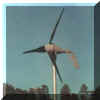 Click
on image to enlarge Click
on image to enlarge
just £658.90
380 watts of power for less than £700, only 2 moving parts, easy installation on 2" pipe
12vdc output, 300 watts at 28mph, 380
at 35mph, 100 at 20mph.
AIR1 is a revolutionary modular wind
turbine Now wind power can be captured as simply as solar power: Priced about the same as
a photovoltaic module, AIR produces more than five times the peak power of a panels rated
output
1.14 metre diameter (45") blade,
min start up speed 7mph.
Maintenance-free performance, easy
installation and high output make AIR ideal for all applications.
The AIR wind module is engineered to
be mounted on a rooftop no tower required. AIR can be used in combination with
photovoltaic modules and/or multiple AIR modules can be installed to meet your power
needs. Five wind modules will provide a 1,5 kilowatt rating [2.0+ kilowatt peak)
AIR
applications
• Remote homes &
cabins• Battery charging
• Water pumping• Science
& education
• Recreational vehicles•
Telecommunications
Features
Unprecedented 3 YEAR WARRANTY
•Simple rooftop installation: no
tower necessary
•Variable pitch aerolastic
carbon matrix blades
•Aircraft quality aluminium
alloy castings
•Exclusive Brushless neodymium
cubic curve alternator
•Sophisticated internal battery
charge regulator
•Safety protection electronics
controls voltage and rotor RPM
•Maintenance-free, Only two
moving parts
 Click
on graph to enlarge Click
on graph to enlarge
BUILD YOUR OWN
WIND FARM FROM SCRAP!
A comprehensive guide to building
wind driven electricity generators using parts
from scrap yards. Covers everything
from sizing the propeller to actually making it
from scrap materials! For anybody
interested in this fascinating
area of energy production it will
make interesting reading.
 Click
on sketch to enlarge Click
on sketch to enlarge
If you want to be emailed when we get
new items in click here
sales@bull-electrical.com
A Bullnet site
|